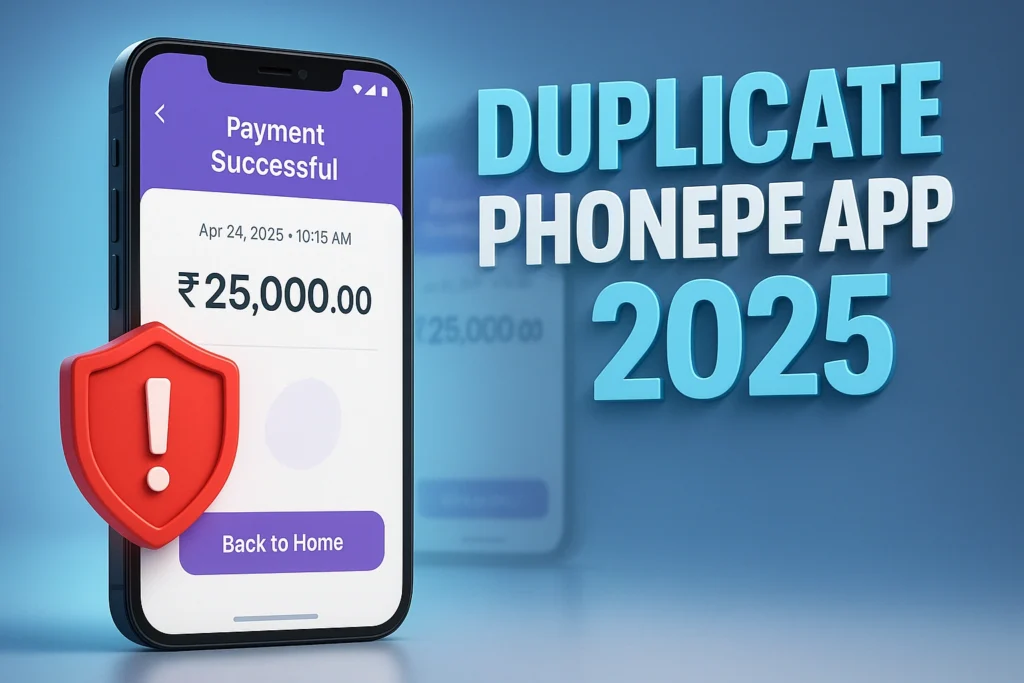In the ever-evolving world of digital payments, duplicate PhonePe apps have become a silent yet serious threat in 2025. These aren’t official or updated versions of the original app — they are lookalike clones designed to deceive.
From auto-generated fake payment ticks to screens that simulate transaction success, these clones mirror the real PhonePe interface but offer no actual money transfer. They’re often distributed through shady APK sites, Telegram groups, or forwarded links.
- 🔍 What Is a Duplicate PhonePe App?
- 🧠 How These Clones Operate (Behind the UI)
- 🧾 Spot the Differences: Real vs Clone
- 🔎 Why Users Are Getting Tricked in 2025
- 🚫 Sources of These Duplicate Apps
- 🧯 How to Fix It If You Installed One
- 🛡️ Tips to Avoid Cloned Apps in Future
- 💬 Final Thoughts from M Raj
- 📌 Related Reads to Protect Yourself:
🔍 What Is a Duplicate PhonePe App?
A duplicate PhonePe app is a cloned version of the original mobile wallet. It’s not authorized by PhonePe, doesn’t use official UPI systems, and is often used to:
- Trick sellers or vendors into accepting fake payments
- Record user data without consent
- Generate false screenshots of successful UPI transfers
Unlike modded apps that unlock features, these clones focus on mimicking UI to commit fraud.
🧠 How These Clones Operate (Behind the UI)
While these apps look nearly identical, their backend operations are completely different:
- Fake apps use offline display logic instead of real-time bank linking
- “Payments” are just on-screen animations
- No actual connection to NPCI, UPI, or your bank account
- OTPs, if shown, are auto-generated and do not trigger real security layers
🚨 Common features include:
- “Edit amount” options
- “Success” tick with sound
- Fake UTR generator
- Fake merchant/bank name entry
🧾 Spot the Differences: Real vs Clone
| Feature | ✅ Official PhonePe | ❌ Duplicate Clone App |
|---|---|---|
| Source | Play Store / App Store | Telegram, APK sites |
| Developer Name | PhonePe Pvt. Ltd. | Unknown or Blank |
| Security Protocols | Bank, UPI, NPCI Verified | None (emulated only) |
| OTP Flow | Real OTP from bank | No OTP or dummy OTP |
| Transaction Log | Synced with bank | Local-only, can’t be verified |
| Legal Compliance | Follows RBI norms | Violates all financial laws |
🔎 Why Users Are Getting Tricked in 2025
Here’s how most victims unknowingly fall for duplicate apps:
- Shopkeepers receive a “payment made” message on WhatsApp
- Students try “premium unlocked” APKs claiming to send money
- Users click on pop-up ads saying “get fast PhonePe version”
- Telegram channels distribute “business tools” with hidden APK links
These clones are lightweight, fast-loading, and look just like the original — which makes them more dangerous.
🚫 Sources of These Duplicate Apps
Avoid downloading apps from the following:
- Telegram mod channels
- Third-party APK-sharing websites
- App bundles from YouTube/TikTok UPI trick videos
- WhatsApp forwards with “UPI Booster” apps
🔗 Related content to explore:
🧯 How to Fix It If You Installed One
Step-by-step actions you must take:
- Delete the fake app immediately
- Go to Play Store or App Store and reinstall the official version
- Run a security scan with trusted antivirus software
- Change your UPI PIN immediately
- Report the case to:
🛡️ Tips to Avoid Cloned Apps in Future
- Always install apps only from the Google Play Store or Apple App Store
- Check the developer name before downloading (must be PhonePe Pvt. Ltd.)
- Never install APKs sent via messaging apps or Telegram
- Be suspicious of apps with “zero OTP,” “instant pay,” or “premium unlock” tags
🧠 Rule of thumb: If an app doesn’t ask for real OTP or UPI PIN → it’s fake.
💬 Final Thoughts from M Raj
“Cloned apps are like shadows — they follow the look of the real thing but lack its value. One tap could cost you your money or your digital identity. In 2025, trust is not in how an app looks, but where it came from.”

